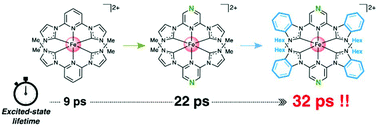Iron(ii) complexes with diazinyl-NHC ligands: impact of π-deficiency of the azine core on photophysical properties†
Abstract
Ligand field enhancing N-heterocyclic carbene (NHC) ligands were recently shown to prevent photo-induced spin crossover in Fe(II) complexes due to their intricate effects on the electronic excited state structure. Due to their pico- to nanosecond lifetimes, these complexes are now good candidates for photo-sensitizing applications. Herein we report the synthesis and photophysical characterization of a new family of homoleptic Fe(II) complexes with C^N^C ligands involving diazines as the central N-heteroaromatic ligand. For these four carbene bond complexes, ultrafast transient absorption spectroscopy revealed a significant improvement of the excited-state lifetime. A record 32 ps lifetime was measured for a complex bearing a ligand combining a π-deficient pyrazine nucleus and a benzimidazolylidene as NHC. When compared to other azine-based ligands investigated, we argue that the lifetimes are modulated by a small excited state barrier expressing the ability of the ligand to reach the Fe–N distance needed for internal conversion to the ground state.

- This article is part of the themed collection: Nitrogen Ligands


 Please wait while we load your content...
Please wait while we load your content...